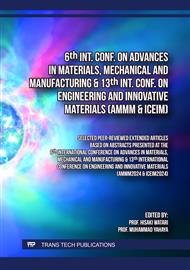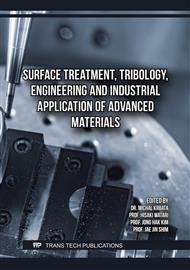p.3
p.9
p.17
p.27
p.41
p.57
p.65
p.73
The Effects of MQL Pulse Parameters on Cutting Force, Cutting Temperature and Surface Roughness in Turning Process
Abstract:
This study aims to investigate the effects of Minimum Quantity Lubrication (MQL) independent pulse parameters, which are the intervals between two pulses (1, 2, and 3 seconds) and the duration of the lubricant application (1, 2, and 3 seconds), in the turning of AISI 1040 steel. MQL pulse parameters supplying the best lubrication in terms of cutting force, cutting temperature, and surface roughness were 1 second interval between pulses and 3 seconds duration of lubricant application. These parameters provided 10.7%, 43.6%, and 65.5% improvement in cutting force, cutting temperature and surface roughness values, respectively, compared to dry cutting conditions. When the MQL pulse parameters were compared among themselves, an improvement of 6.7%, 38.3% and 61.7% was achieved in the cutting force, cutting temperature, and surface roughness values, respectively, in the conditions that gave the worst and the best results. According to ANOVA (Analysis of variance) results, the duration of the lubricant application was determined as the most important parameter on the surface roughness and resultant force whereas the interval between two pulses was obtained the most important parameter on the cutting temperature.
Info:
Periodical:
Pages:
3-8
Citation:
Online since:
June 2025
Authors:
Price:
Сopyright:
© 2025 Trans Tech Publications Ltd. All Rights Reserved
Share:
Citation:



